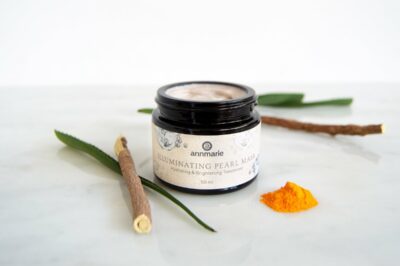Why do some cleansers work better than others?
Why is it after using one cleanser, your skin feels clean but dry and tight, whereas after using another, your skin feels soft and smooth?
Though there are many differences between various skin care products that can affect the condition of skin, one of the most important is the pH level.
A pH level that is too alkaline will disrupt the skin’s acid mantle, leaving it vulnerable to bacterial and environmental attack, and accelerating the aging process.
So what exactly does pH have to do with skin, and what is an “acid mantle?” Knowing the answers to these questions will help you become a savvier consumer—and enjoy healthier, more radiant skin.
What is a pH level?
The term “pH” stands for “power of hydrogen,” and is a way to measure the acidity or alkalinity of a solution. If you’re into chemistry, you know that an acid has more hydrogen ions than hydroxide ions, whereas a base (a more alkaline solution) has more hydroxide than hydrogen ions.
But if that all sounds like a foreign language, all you have to remember is that you can discover how acidic (or not) a solution is by its pH level. The scale goes from 0 to 14, with 0 being the most acidic, and 14 being the most alkaline. In the middle is “7” which describes a “neutral” solution, neither acidic nor alkaline.
Solutions at the extremes of either end of the scale can be dangerous to humans, and can cause burns.
Examples of acidic solutions
Battery acid has a pH level of “0”
Gastric acid, or stomach acids, have a pH level of “1”
Lemon juice and vinegar have a pH level of “2”
Orange juice and sodas have a pH level of “3”
Examples of alkaline solutions
Liquid drain cleaner has a pH level of “14”
Black and oven cleaner have a pH level of “13”
Soapy water has a pH of “12”
In the middle, we have water, which has a pH of “7.”
So what does all this have to do with skin?
What is the acid mantle?
On the surface layer of skin is a very thin, natural protective film that’s made up of sebum (skin oils), amino acids, fatty acids, lactic acid, water (from perspiration), and skin’s own natural moisture. This is called the skin’s “acid mantle.”
Makes sense, because this layer is naturally acidic, with a pH level between 4.5 and 5.5. That explains the “acid” part. “Mantle” means a type of cloak or envelope, so the term “acid mantle” can be translated to an acidic cloak for the skin.
What does the acid mantle do?
- Protects from environmental assaults like harsh weather and pollution.
- Reduces risk of infection and/or occasional breakouts.
- Secretes enzymes that help break down excess sebum, keeping skin oils in balance.
- Helps to soften skin and keep it hydrated.
- Works with the skin’s own immune system to produce antigens that keep bad bacteria away.
- Help keep skin cells tight and flat, promoting a smooth, strong barrier.
- Prevents against water loss.
When we consider all the benefits that the acid mantle creates, it becomes obvious that we want to do what we can to protect it and help it thrive.
Unfortunately, many cleansers do just the opposite.
How some cleansers damage the acid mantle
Look back at the bulleted lists above and you’ll see that “soapy” water is listed as a very alkaline solution, with a pH level of “12.”
Compare that with the skin’s acid mantle pH level of between 4.5-5.5.
Doesn’t quite match, does it?
That’s the problem with most skin cleansers. They upset the natural pH balance of skin. You’ve likely experienced this. It usually happens during the winter months, when we’re washing our hands more often to avoid transmitting the cold and flu. The more you wash your hands, the dryer they get, right?
Elementary teachers know how this goes firsthand. They’re constantly washing to protect themselves from illnesses, but their hands pay the price. Dryness, cracking, calluses, and an overall aged look is usually the result.
pH disruption
Washing with good old soap and water changes the skin’s naturally acidic pH to be more alkaline, because soapy water is so much more alkaline than the skin’s outer later. This strips the skin of its natural moisture and fatty acids.
Upsetting the pH balance can lead to redness, breakouts, and dry skin. (That’s why you can get breakouts and dry skin at the same time.)
Soaps and facial cleansers with detergents (like sulfates and their derivatives) may leave your skin feeling “squeaky-clean,” but don’t be fooled—they could be damaging the acid mantle and disrupting the skin’s barrier function. Just one use will challenge skin for a little while, but it will recover. Regular use, however, can gradually wear away skin’s ability to regenerate a healthy acid mantle.
The more you wash, the drier your skin gets, and over time, this leads to accelerated aging. It’s why you see more fine lines and wrinkles, sagging, and more.
In short, cleansing with the wrong products can spell disaster for your skin!
Symptoms of a disrupted acid mantle
How do you know if your skin is suffering from a damaged acid mantle? Here are some of the common symptoms:
- Dryness and flaking
- Tightness
- Excessive oil
- Breakouts
- Sensitivity
- Redness
- Temporary irritation and itching
- Reactivity
- Premature signs of aging (fine lines, wrinkles, sagging)
- Pores that appear larger
The solution: pH-balanced cleansers
This is why it’s so important that your cleanser is pH balanced for skin. Cleansers that are properly formulated to be slightly acidic, like skin’s acid mantle, work with skin to cleanse without stripping, upsetting, and drying.
Though many cleansers say they’re pH-balanced, be cautious. Some still have harsh cleansers in them, which will work against skin’s natural system. Natural oils are your best bet for any skin care product, because they are similar in structure to the skin’s lipid layer, and they are much gentler than detergents.
When these are combined in a solution that is slightly acidic, you have a winning combination, and one that your skin will naturally respond to.
If your goal is smooth, radiant skin, start with the best cleanser you can find!
Try it!
Both of our cleansers are pH balanced and infused with herbs to deliver potent nutrients to your skin. The base is aloe vera, so each time you wash your face you are also helping to soothe and hydrate it.
The Citrus Mint Cleanser is designed for those with oily skin and clogged pores. It also has the ability to reduce the appearance of large pores and is infused with herbs like neem and rosemary.
The Aloe Herb Cleanser is creamier and moisturizing. It has a bit more coconut oil than the Citrus Mint, and leaves skin soft and glowing.
Explore our facial cleansers collection with various options for your needs.
How to Choose the Best All Natural Face Cleanser for Your Skin









I am so happy with the Citrus Mint and Aloe Herb cleansers. I alternate using them, but prefer the Aloe Herb. My face feels clean and fresh after cleansing, but not dry. Using it is such a pleasant, aromatic experience that I actually look forward to cleansing my face each night! ????
So happy for you Karen